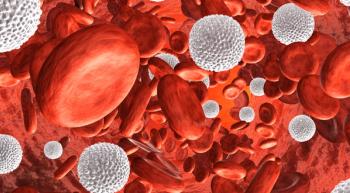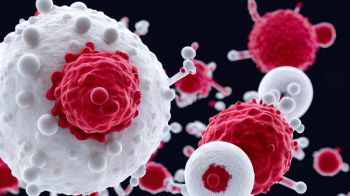
Topical Diclofenac Gel Reduces Capecitabine-Related Hand-Foot Syndrome
Patients with breast and gastrointestinal cancers reported fewer hand-foot syndrome events following treatment with topical diclofenac gel.
Treatment with topical diclofenac gel significantly reduced the number of grade 2 or 3 cases of hand-foot syndrome (HFS) among patients with cancer receiving capecitabine, according to findings from the D-TORCH study (CTRI/2021/01/030592; NCT05641246), presented during the 2023 American Society of Clinical Oncology Annual Meeting. Further, patients who received the gel also reported lower incidence rates of any grade HFS events, fewer dose reductions of capecitabine, and better HFS-related quality of life (QOL).
Overall, 25 patients (9.5%) experienced either grade 2 or worse HFS in the study. In the intervention vs control arms, the rate of grade 2/3 HFS was 3.8% (n = 5) vs 15.0% (n = 20). According to the study authors, this translated to a 75% reduction in the risk of developing grade 2 or 3 HFS (RR, 0.25; 95% CI, 0.10-0.066; P = .003).
“The trial supports diclofenac gel as the new standard of care to prevent capecitabine-associated HFS,” Atul Batra, MD, DM, associate professor with the department of medical oncology at the All India Institute of Medical sciences, said in a presentation of the data.
As Batra explained, capecitabine is an anticancer agent that is widely used to treat patients with gastrointestinal and breast cancers. HFS is a common adverse event (AE) associated with capecitabine. The rate of incidence is variable but is reported to be between 25% and 75% of patients. Although HFS is not life-threatening, it can impair QOL and result in dose reductions in approximately 10% to 25% of patients who experience it.
Celecoxib (Celebrex) is efficacious in this setting; however, there are safety concerns with celecoxib. Therefore, investigators sought to leverage a difference cyclooxygenase-2 (COX-2) inhibitor. Because topical COX inhibitors are widely used to treat osteoarthtiris, and are associated with a well-known safety profile, investigators hypothesized that topical diclofenac, a COX inhibitor, could be useful in this setting.
The study period lasted from February 2021 to September 2022, and the last patient had their 3 month follow-up on January 2023, with a data-cutoff on March 31, 2023. To participate, patients needed to be at least 18 years or older, have an ECOG performance status (PS) between 0 and 2, have a diagnosis of either breast or gastrointestinal cancer and not be receiving an oral or topical nonsteroidal anti-inflammatory drugs (NSAIDs). They also could not have any known allergy to NSAIDS. The primary study end point was incidence rate of grade 2 or worse HFS. Secondary end points included time to HFS, all grade HFS, patient-reported outcomes, capecitabine dose modifications, and safety. Patients were assessed every 3 weeks for efficacy and safety outcomes.
Patients who participated in this study who were randomly assigned to the intervention arm were asked to apply 1 fingertip unit (FTU) 1% of topical diclofenac on their hands twice daily.
The study lasted for 12 weeks, or 4 treatment cycles, or until patients developed grade 2 or worse HFS, or experienced other dose limiting toxicities. Treatment could also be stopped per the treating physician’s discretion.
The median patient age in both arms was 47 years. Approximately 71% of patients in either arm were female (70.0% vs 72.2%). Most patients had an ECOG PS between 0 and 1 (64.6% vs 60.2%), had received combination therapy (56.9% vs 60.9%) and had received a mean dose of capecitabine of approximately 1881.2 mg/m2 (SD, 186.5). In the doclifenac arm (n = 130), 59.2% of patients had breast cancer and 40.8% had gastrointestinal cancer. In the placebo arm (n = 133), 53.4% vs 46.6% of patients had breast and gastrointestinal malignancies, respectively.
The findings in favor of diclofenac gel were maintained across the various subgroups. This included sex, with male and female patients have an RR of 0.19 (95% CI, 0.02-1.55) and 0.28 (95% CI, 0.10-0.82), respectively. Patients who received combination therapy demonstrated an RR of 0.33 (95% CI, 0.09-1.15). For those receiving capecitabine as monotherapy, the RR was 0.18 (95% CI, 0.04-0.81).
Patients with an ECOG PS of 2 receiving diclofenac had an RR of 0.51 (95% CI, 0.17-1.55) vs placebo. Those with an ECOG PS of either 0 or 1 had an RR of 0.09 (95% CI, 0.01-0.65). RR was balanced between those who had breast cancer (RR, 0.25; 95% CI, 0.7-0.86) and those who had gastrointestinal cancer (RR, 0.26; 95% CI, 0.06-1.15).
The rate of all-grade HFS with placebo vs diclofenac was 18.1% (n = 24) vs 6.1% (n = 8), yielding an absolute risk difference of 11.9% (95% CI, 4.1%-19.6%; P = .002). The rates of grade 1, 2, and 3 HFS, specifically, between the diclofenac and placebo arms was 2.3% (n = 3) vs 3.0% (n = 4), 1.5% (n = 2) vs 9.8% (n =13), and 2.3% (n = 3) vs 5.3% (n = 7).
In the diclofenac arm, the onset time to HFS was 3 weeks for 1 low-grade event, 6 weeks for 3 low-grade events, and 9 weeks for 4 low-grade events. There were 3 grade 2/3 HFS events that developed at week 6, and 2 grade 2/3 HFS events that developed at week 9. In the placebo arm, the onset time was 3 weeks for 2 events (any grade), 6 weeks for 6 events, 9 weeks for 10 events, and 12 weeks for 6 events. In terms of grade 2/3 events, the time to onset was 3 weeks for 1 patient, 6 weeks for 5 events, 9 weeks for 7 events, and 12 weeks for 7 events.
The percentage of patients who required a capecitabine dose reduction because of HFS was much lower in the diclofenac arm than with placebo, respectively. The rates of reductions were 3.8% (n = 5) vs 13.5% (n = 18).
Other contributing factors for dose reductions, in both arms, included mucositis (3.8% vs 7.5%), diarrhea (6.1% vs 6.0%), and myelosuppression (2.3% vs 3.8%).
The QOL assessments were completed by 100 patients (84.6%) in the diclofenac arm and 106 patients (79.7%) in the placebo. The assessments demonstrated that the mean increase in HFS14 score was 8.7 with placebo vs 2.3 with intervention. Higher scores correlate to worse QOL.
Batra concluded by noting that the number of events were reported, overall, were less than the investigators anticipated. They hypothesized that the placebo effect may have played a role, they also noted that the mean treatment dose with capecitabine was less than 2000 mg/m2 and that may have contributed.
Reference
Santhosh A, Kumar A, Pramanik R, et al. Randomized double-blind, placebo-controlled study of topical diclofenac in prevention of hand-foot syndrome in patients receiving capecitabine. J Clin Oncol. 2023;41(suppl 16):12005. doi:10.1200/JCO.2023.41.16_suppl.12005
Newsletter
Knowledge is power. Don’t miss the most recent breakthroughs in cancer care.
















































































